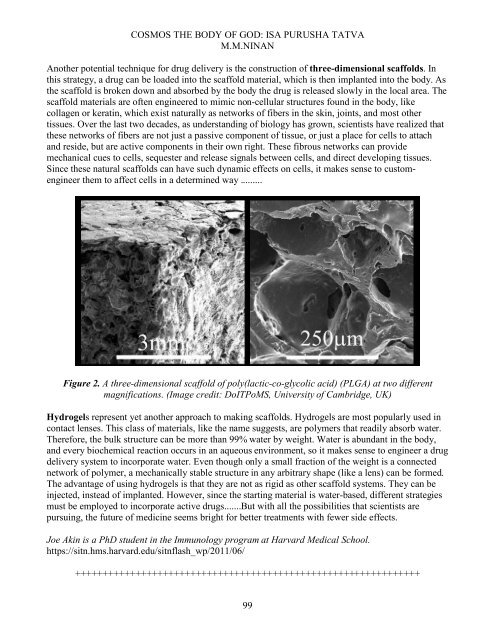You also want an ePaper? Increase the reach of your titles
YUMPU automatically turns print PDFs into web optimized ePapers that Google loves.
COSMOS THE BODY OF GOD: ISA PURUSHA TATVA<br />
M.M.NINAN<br />
Another potential technique for drug delivery is the construction <strong>of</strong> three-dimensional scaffolds. In<br />
this strategy, a drug can be loaded into the scaffold material, which is then implanted into the body. As<br />
the scaffold is broken down and absorbed by the body the drug is released slowly in the local area. The<br />
scaffold materials are <strong>of</strong>ten engineered to mimic non-cellular structures found in the body, like<br />
collagen or keratin, which exist naturally as networks <strong>of</strong> fibers in the skin, joints, and most other<br />
tissues. Over the last two decades, as understanding <strong>of</strong> biology has grown, scientists have realized that<br />
these networks <strong>of</strong> fibers are not just a passive component <strong>of</strong> tissue, or just a place for cells to attach<br />
and reside, but are active components in their own right. These fibrous networks can provide<br />
mechanical cues to cells, sequester and release signals between cells, and direct developing tissues.<br />
Since these natural scaffolds can have such dynamic effects on cells, it makes sense to customengineer<br />
them to affect cells in a determined way .........<br />
Figure 2. A three-dimensional scaffold <strong>of</strong> poly(lactic-co-glycolic acid) (PLGA) at two different<br />
magnifications. (Image credit: DoITPoMS, University <strong>of</strong> Cambridge, UK)<br />
Hydrogels represent yet another approach to making scaffolds. Hydrogels are most popularly used in<br />
contact lenses. This class <strong>of</strong> materials, like the name suggests, are polymers that readily absorb water.<br />
Therefore, the bulk structure can be more than 99% water by weight. Water is abundant in the body,<br />
and every biochemical reaction occurs in an aqueous environment, so it makes sense to engineer a drug<br />
delivery system to incorporate water. Even though only a small fraction <strong>of</strong> the weight is a connected<br />
network <strong>of</strong> polymer, a mechanically stable structure in any arbitrary shape (like a lens) can be formed.<br />
The advantage <strong>of</strong> using hydrogels is that they are not as rigid as other scaffold systems. They can be<br />
injected, instead <strong>of</strong> implanted. However, since the starting material is water-based, different strategies<br />
must be employed to incorporate active drugs.......But with all the possibilities that scientists are<br />
pursuing, the future <strong>of</strong> medicine seems bright for better treatments with fewer side effects.<br />
Joe Akin is a PhD student in the Immunology program at Harvard Medical School.<br />
https://sitn.hms.harvard.edu/sitnflash_wp/2011/06/<br />
+++++++++++++++++++++++++++++++++++++++++++++++++++++++++++++++<br />
99


















